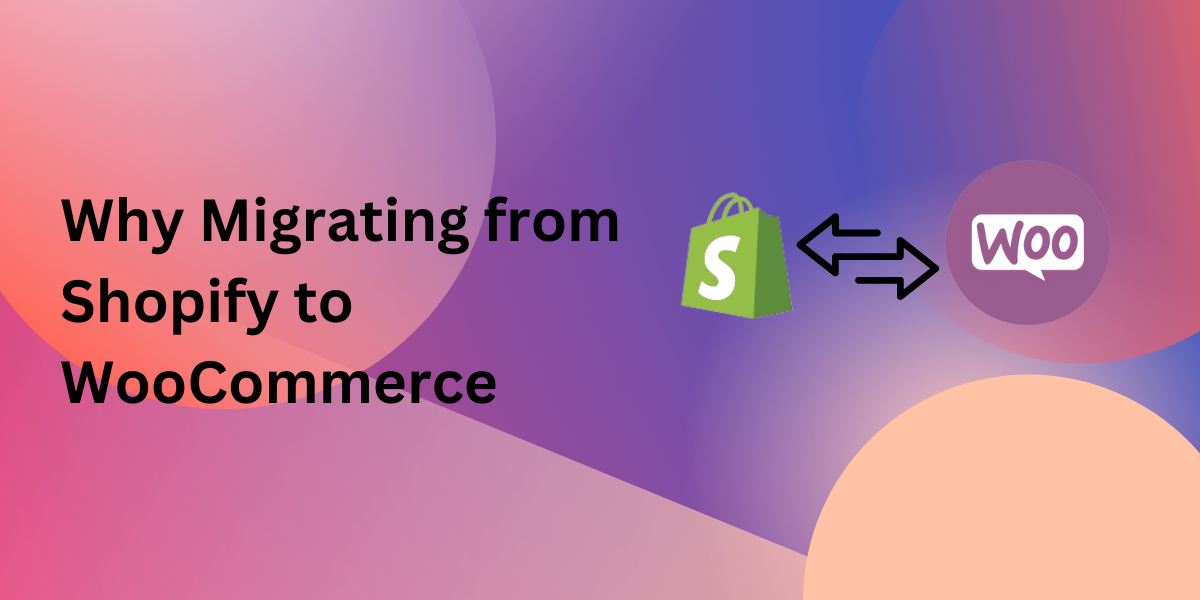In the dynamic world of eCommerce, choosing the right platform is crucial for the success of your online business. Shopify and WooCommerce are two of the most popular platforms, each offering unique features and benefits. However, many businesses are making the strategic decision to migrate from Shopify to WooCommerce. This shift is driven by the need for more flexibility, control, and cost-effectiveness—key aspects that WooCommerce excels in.
In this article, we will explore the reasons why migrating from Shopify to WooCommerce is a smart move for your business, the benefits WooCommerce offers over Shopify, and the migration process to ensure a seamless transition.
1. Greater Flexibility and Customization
One of the primary reasons businesses choose to migrate Shopify to WooCommerce is the superior flexibility and customization options offered by WooCommerce. Shopify, while user-friendly and easy to set up, comes with limitations in terms of customization. It relies heavily on apps, some of which come at a cost, to extend its functionality. Moreover, customizing the backend requires knowledge of Shopify’s proprietary coding language, Liquid, which can be restrictive for developers accustomed to more open-source environments.
WooCommerce, on the other hand, is a WordPress plugin, meaning it inherits the open-source nature of WordPress. This allows for unlimited customization options. With WooCommerce, you have complete control over the look, feel, and functionality of your store. You can add custom code, build your own plugins, or choose from a vast library of free and premium extensions to tailor your store to your exact needs. This level of customization is ideal for businesses looking to create a unique shopping experience that stands out in a competitive market.
2. Cost-Effectiveness
While Shopify offers a range of pricing plans, many businesses find that costs can quickly add up due to subscription fees, transaction fees, and the need for paid apps to access advanced features. Shopify’s basic plan starts at $39 per month, and costs increase significantly with the addition of apps, themes, and transaction fees. Additionally, if you opt for a payment gateway other than Shopify Payments, transaction fees apply, further driving up costs.
WooCommerce, being an open-source platform, is free to install and use. Although there are costs associated with hosting, domain registration, premium themes, and extensions, you have the flexibility to choose options that fit your budget. Moreover, WooCommerce does not charge transaction fees, allowing you to keep more of your profits. The ability to select your hosting provider and scale your costs as your business grows makes WooCommerce a cost-effective solution for eCommerce.
3. Full Ownership and Control of Your Data
Data ownership is another critical factor when choosing an eCommerce platform. With Shopify, your data is hosted on Shopify’s servers, and while you can export some data, you don’t have full control over it. This reliance on a third-party platform can be a concern for businesses that prioritize data security and privacy.
WooCommerce, as part of the WordPress ecosystem, allows you to host your store on your own server. This means you have full ownership and control of your data, with no restrictions on how you can use or export it. This autonomy not only provides peace of mind but also ensures compliance with data protection regulations, such as GDPR, which can be a critical factor for businesses operating in multiple regions.
4. SEO and Content Management Advantages
Search engine optimization (SEO) is essential for driving organic traffic to your online store. WooCommerce, being built on WordPress, excels in this area. WordPress is renowned for its robust SEO capabilities, allowing you to optimize every aspect of your site, from meta descriptions to alt tags, permalinks, and more. Additionally, you can use powerful SEO plugins like Yoast SEO to further enhance your store’s visibility in search engines.
Shopify offers basic SEO functionalities, but it lacks the depth and flexibility that WooCommerce provides. With WooCommerce, you can create an integrated content marketing strategy by seamlessly blending your store with a blog, landing pages, and other content-rich sections. This holistic approach to content and SEO is crucial for businesses looking to improve their search engine rankings and attract more organic traffic.
5. Enhanced Scalability and Growth Potential
WooCommerce offers unmatched scalability, making it suitable for businesses of all sizes, from startups to large enterprises. As your business grows, you can easily add more products, handle increased traffic, and expand your site’s functionality without significant changes to your infrastructure. WooCommerce’s open-source nature means you can scale your store in line with your growth without worrying about platform limitations.
In contrast, Shopify’s scalability comes at a cost. Higher-tier plans are required for advanced features and capabilities, and these plans can become expensive as your store grows. WooCommerce provides the flexibility to build and scale your store at your own pace, making it an ideal choice for long-term growth.
6. Extensive Community and Support Resources
WooCommerce boasts a large, active community of developers, designers, and users who contribute to its ongoing development and support. This community-driven approach means there are always new plugins, updates, and enhancements being made available. Additionally, the wealth of tutorials, forums, and documentation makes it easier to find solutions to any challenges you might encounter.
While Shopify also offers support and resources, the WooCommerce community provides a more open, collaborative environment where users can share their experiences and solutions freely. This collaborative spirit makes WooCommerce a continually evolving platform that adapts to the changing needs of eCommerce businesses.
7. Simplified Migration Process
Migrating from Shopify to WooCommerce is easier than ever, thanks to dedicated tools and services that streamline the process. The WooCommerce “Migrate & Import Shopify to WooCommerce” tool allows you to transfer your products, customers, and orders from Shopify to WooCommerce with just a few clicks. This tool ensures that your data is migrated accurately and securely, minimizing downtime and disruption to your business.
The migration process is designed to be user-friendly, even for those without technical expertise. Detailed documentation and support are available to guide you through each step, ensuring a smooth transition. Whether you choose to handle the migration yourself or enlist the help of a professional service, you can be confident that your move from Shopify to WooCommerce will be straightforward and efficient.
Conclusion
Migrating from Shopify to WooCommerce offers numerous advantages for businesses seeking greater flexibility, control, and cost savings. With WooCommerce, you gain full ownership of your data, extensive customization options, superior SEO capabilities, and a scalable platform that grows with your business. The migration process is made simple with dedicated tools and support, allowing you to seamlessly transition to WooCommerce and start reaping the benefits.
By choosing WooCommerce, you are investing in a platform that prioritizes your business’s needs and puts you in control of your online store’s future. Whether you’re looking to reduce costs, improve your store’s functionality, or enhance the shopping experience for your customers, migrating from Shopify to WooCommerce is a strategic move that can set your business on the path to success.




